All about Hemanthus: description of varieties and home care

The variety of plants for indoor growing is striking: small and large, tree-like and ampelous, with and without flowers, for flowerpots and floor vases, for dark corners and light window sills. But if you want a bright sun flower in the house that does not take up much space, then you should definitely choose a hemantus - a fluffy miracle with a rich color and varietal palette. Therefore, today we will talk about the popular varieties of this flower and about caring for it at home.
Description
Haemanthus is a large genus of the Amaryllidaceae family, whose name is translated from Latin as "bloody flower". Among flower growers, it is known as "elephant's ear" or "deer tongue". The leaves of the plant, indeed, resemble the tongue of a deer: wide, curved, even with a longitudinal dimple. From each tender bulb, the flower produces 1-3 pairs of wide leaves, arranged symmetrically and hanging on both sides. Only 1 pair appears in one season. In some species, the leaf plates are glossy, in others - pubescent, in others - sticky.
Even during dormant winter, this tropical evergreen or deciduous crop continues to grow. And already during the flowering period, which lasts from mid-summer to the end of autumn, hemantus pleases with umbrella inflorescences. They are not in fact flowers, but you cannot take your eyes off the bright bracts. The fluffiness of the inflorescences is given by hundreds of small umbrellas of bright colors, which are surrounded by several fleshy bracts of the same color with the stamens. Looking at the inflorescences of this indoor plant, it seems that this is a relaxation - a toy or a pompom, they are so similar.
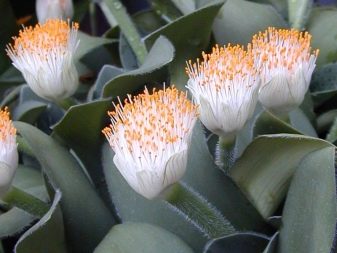
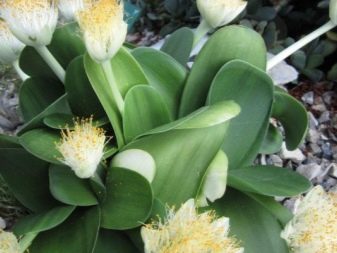
The only reason why the popularity of "deer tongue" does not go off scale is the smell. Other flowers try to attract insects for pollination with their aroma. Gemantus is a self-pollinated plant, so he gets rid of obsessive insects with unpleasant amber. Pollination results in round white-red berries with a diameter of 1-2 cm, which are tied to the arrows. The seeds ripened in the berries remain viable for a very short time, but still new plants have time to appear.
The homeland of the "elephant ear" is the tropics of Africa. The plant came to Europe in the 18th century and fell in love with its ease of care. The only thing to be wary of is poisoning or burns from contact with the bulb and, possibly, berries (the plant has the status not poisonous, but low toxic). Realizing that this is possible, you need to work with gloves and keep the plant away from children and animals. After the appearance and ripening of berries, flower growers with small children in the house are advised to cut the inflorescences for safety reasons. But what a beautiful window sill will be if there is a mini-greenhouse on it from several varieties of different shades of this beautiful plant.

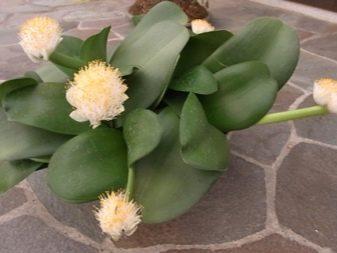
Varieties
According to various sources, at the moment, from 20 to 40 types of indoor hemantus are known. But there are time-tested, favorite species and varieties.
- White-flowered - one of the most popular species because of the fluffy white inflorescences decorated with golden stars. The leaf plates are fleshy, smooth, but have small denticles at the edges. Blooms all autumn and half of winter. Biologists call this species the base for many hybrids. For example, the Prince Albert variety has long overtaken the basic form in terms of distribution. Differs in twice as large saturated orange inflorescences.
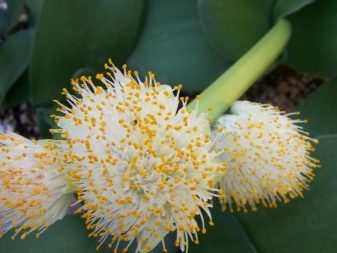
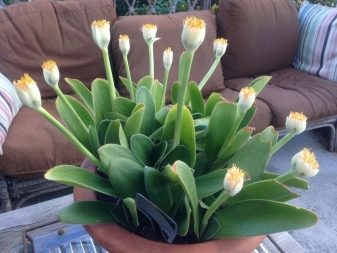
- Pure White Hemantus - This is a kind of white-flowered.It differs not only in the color of the inflorescences, but also in the fluffy leaves, as well as in the red bracts.
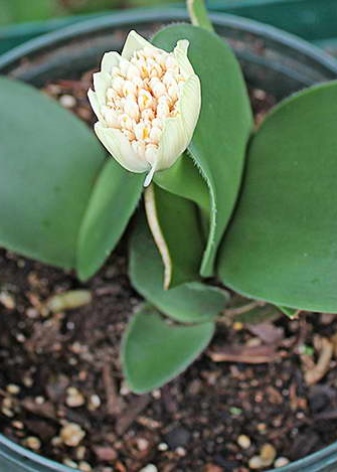
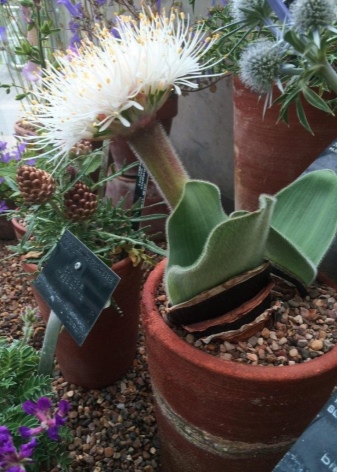
- Pomegranate - narrow elongated wavy green leaves, green or burgundy bracts and red-yellow inflorescences 10 cm in diameter. The flower blooms in summer.
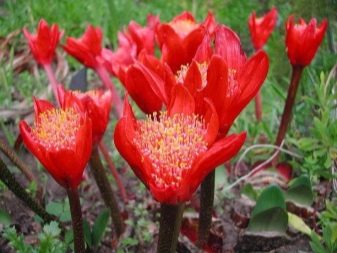
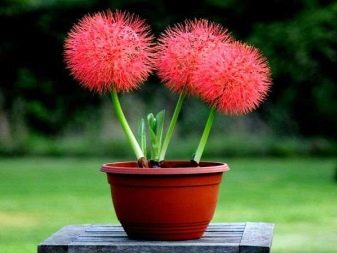
- Multi-flowered also blooms in large numbers in spring with light red or pink umbrellas. The peduncle is very tall, it can be green or red-spotted, and the leaves have a striking pattern of veins. According to modern taxonomy, this species is allocated to a separate genus of Scadoxus, therefore, in Latin, the name of the plant is written as Scadoxus multiflorus.
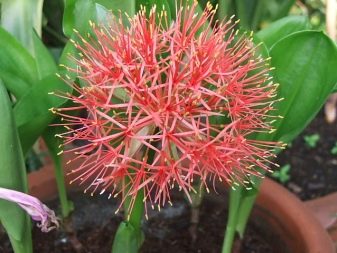
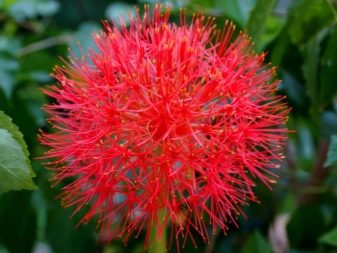
- Gemantus "Katarina" - a variety of multi-flowered species. Its second name "blood lily" is due to the narrow long leaves and bright red inflorescences 20 cm in diameter. A wide, solid spotted arrow grows from 15 to 30 cm.This popular indoor variety blooms in the middle of summer and pleases with its balls until autumn.

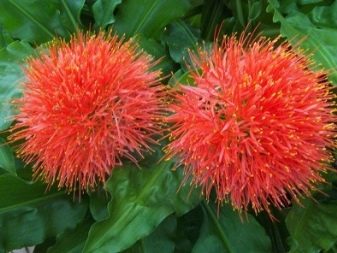
- Tiger view named for the external spotty resemblance to the beast. Against the background of 45-centimeter fringed leaves, a 15-centimeter peduncle appears: glossy red bracts, reddish-bluish inflorescences with bright yellow asterisks. This species is also a product of breeding work.
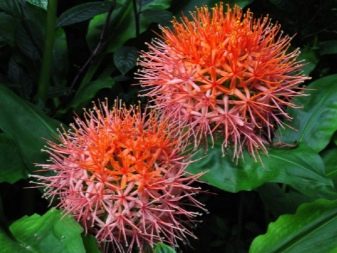

- Cinnabar valued for the fact that it blooms very early - in April - with cinnabar-red inflorescences. Another feature is a high peduncle with underdeveloped leaves.

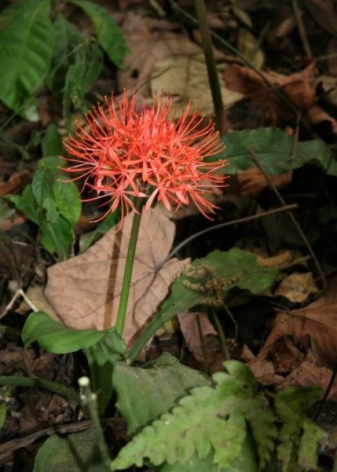
Home care
For such a handsome man, it is important to please the owners with wonderful flowers. But this just does not always work. But the flower growers themselves are to blame for this - they did not follow the elementary rules of care. So, if you want the hemantus to bloom regularly, despite the unpleasant odor, you need to properly care for the plant. Since among all types of "elephant ear" are somewhat related to succulents, growers claim that the care of these plants is similar.
Lighting
The flower prefers diffused lighting, but pretty good. West, east and southeast windows are best suited for growing. In the absence of a protective film, it is better to remove the blinds on the windows of the plant from the windowsills from bright sunlight, as they leave burns on the leaves. Gradually, such leaf plates die off. On northern windowsills, hemantus, as a rule, does not bloom.
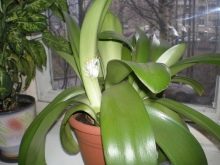
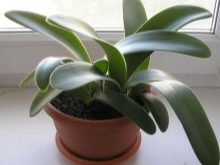

Temperature regime
For flowering "deer tongue" it is important to choose the right temperature regime: the plant needs a dormant period. It comes at the end of November, and then it is kept at a temperature of +10.15 degrees Celsius, often ventilating the room (without drafts). At this time, deciduous species shed their leaves. But the most popular homemade white-flowered hemantus does not have a dormant period, that is, it does not need a temperature drop. From spring to winter, during the period of active growth, the indoor temperature for this flower must be maintained at +19.23 degrees Celsius.
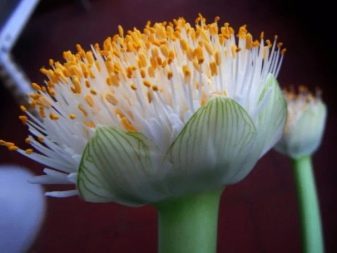
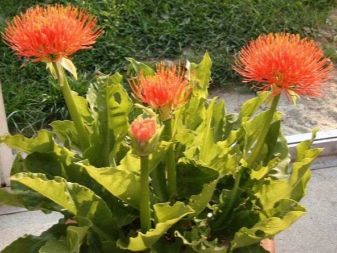
Watering and feeding
Gemantus loves watering in moderation: the top layer of the earth has dried up - water the plant again. It is better to underfill the flower than to pour it over. The rest of the water from the sump must be poured out. Winter watering depends on whether the species is evergreen or deciduous, whether it has a dormant period. If the flower “goes into hibernation” (and these are primarily deciduous species), then watering it in winter is done to a minimum, slightly moisturizing the soil. In evergreen species, the volume of water is reduced, but they require more moisture.
The main thing is that it does not stagnate in the pot. In addition, water temperature is important, especially in winter when the ambient air is cool. Chlorinated water requires mandatory settling for 2-3 days. Some people use boiled: although it is considered dead, it becomes softer from boiling. The "summer" version of watering is renewed only when the plant releases a peduncle or the first young leaf.
Despite the fact that the native land of the plant is the tropics, it does not require high humidity, spraying.A warm shower or wet cleaning is more about dust control and pest prevention. Once a month or two, dust deposits should be removed from the plant.

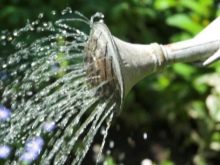
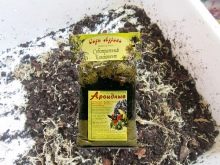
Feeding the flower is needed, but not year-round: during the dormant period and until the flower arrow reaches 10 cm, the hemantus is not fertilized. Sometimes you come across information about the introduction of organic dressings: professionals argue that this does not need to be done categorically. "Deer tongue" should be fertilized with NPK complexes for flowering domestic plants (nitrogen, phosphorus, potassium) in a ratio of 4: 1: 3 or 2: 1: 2. Moreover, it is recommended to choose a concentration 2 times less than the manufacturer recommends. With good soil quality, the flower is fed every 2-3 weeks, with poor soil - after 2 waterings in a very weak concentration.
Transfer
For a typical bulbous plant, a flower pot is selected 3-4 cm more onion. It should not be deep, so that the roots do not grow, and the earth does not sour, but always with drainage holes. For transplanting, use a soil mixture for bulbous flowers. When making a substrate yourself, you can use the following recipes:
- 2 parts of turf + 1 part of garden land + 1 part of peat + 1 part of fine river sand + drainage layer;
- 2 parts of sod land + 1 part of garden + 1 part of humus + 1 part of fine gravel (or zeolite).
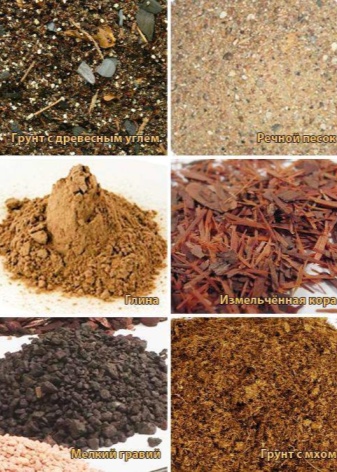

After planting until 4-5 years old, the flower is usually transplanted once a year, but this depends on its growth rate. And then they are transplanted every 3-5 years, increasing the pot for the old bulb so that the roots spread freely, and there was still a drainage layer of 2-3 cm below (vermiculite, gravel, sand, brick chips). Experts recommend using plastic pots, as clay dries up much faster. As soon as roots have appeared from the drainage holes, it is time to replant. If a white salt deposit appears on the surface of the earth, and the roots have not yet grown, then the top layer of the soil is changed.
When transplanting, the substrate laid out on the drainage layer is well watered. The bulb is buried by 2/3 by transshipment. Bulbous roots are very delicate: if an accidental break occurs, they are treated with crushed charcoal or activated carbon for disinfection. The "reindeer tongue" is transplanted during dormancy or early spring, separating the children from the bulb. Rare transplants lead to a decrease in the number of peduncles.
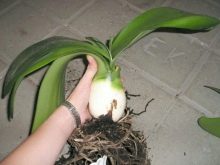
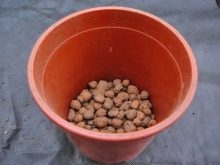

Reproduction
For breeding hemantus use the following ways:
- seeds;
- offspring (cuttings);
- daughter bulbs.
To get your own seeds, two different flowers are pollinated with a brush. Seeds are sown immediately after opening the fruit or within 1-2 months (while the seeds are stored at a temperature of 4-5 degrees Celsius). It is recommended to sow directly into permanent pots, since the hemantus does not like transplanting, picking, any procedures involving the roots. The pot is chosen 9-10 cm in width and 12 cm in height with obligatory drainage holes. For sowing, use a universal soil with vermiculite and sand in equal proportions.
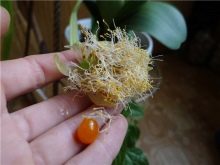
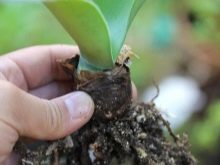
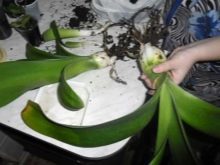
The temperature is maintained at +20.21 degrees, and the illumination is maintained for 16 hours a day. Water the seeds regularly, but little by little. It is recommended to regularly add NPK fertilizers in a ratio of 4: 1: 3. From the moment of germination and up to one and a half years (!), The seedlings are kept under lamps (including phytolamps). Young onions need more moisture than adult plants.
Various sources say that when propagated by seeds, the hemantus will bloom in 2-7 years, and only with good care. Perhaps that is why this method is considered the most time consuming and unreliable.
To propagate the "elephant's ear" by cuttings, a piece of 4 cm is cut off from the leaf plate, the place of the cut is sprinkled with a fungicide, which can be mixed with "Kornevin". You need to take the old leaf, but cut it off during the period of active growth, otherwise it will dry out before the onion appears. A piece of leaf is stuck vertically into a mineral medium such as moistened vermiculite.You can also use a sand-peat mixture or plain water. A new onion is tied within 10-14 days.
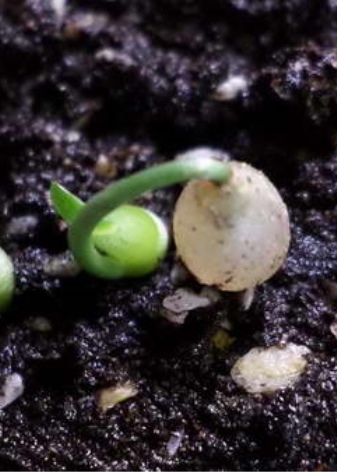

From the moment the cuttings are planted, the soil is constantly moistened. After the onions are formed, they are planted in a fairly large pot for constant growth. With this method of propagation, the plant should bloom in 3-4 years. But if the pot is too large, then the hemantus will give strength to the growth of the roots, and not the peduncle.
The easiest way to reproduce is to separate the babies from the mother's bulb at the time of transplantation. In spring, young bulbs are carefully separated and transplanted into separate pots. Such seedlings take root most easily, and after 3 years they please with the first flowers. But there is no need to rush to plant the children if the pot allows them to grow. The abundance of flower stalks in one pot is always very beautiful.
Mistakes in flower care
The main question that worries flower growers is why the hemantus does not bloom. The flower probably did not have a dormant period: cool content, moderate watering. Perhaps there is not enough fertilizer in the flowerpot or the soil is acidic. And also the flower needs warm water for irrigation and biostimulants. It is important to find a balance between the size of the bulb and the size of the container: the difference in diameter should be 4 cm. Lack of space for foliage will lead to the ejection of the peduncle.
Yellow or sluggish leaves indicate an excess of moisture. And this is the reason for the appearance of gray rot. The plant is treated with a decrease in water, immunostimulants, and in some cases - by transplanting into another soil. But if there are no pests on the flower, the soil is not waterlogged, then the yellow leaves indicate that the hemantus is preparing for a dormant period.
Pale foliage, burns are the result of direct sunlight. The flower must be rearranged from the windowsill, or the glass must be shaded.
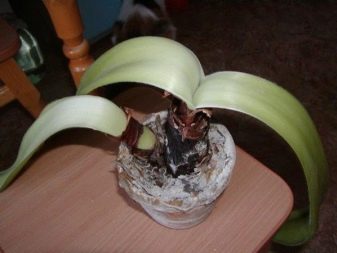
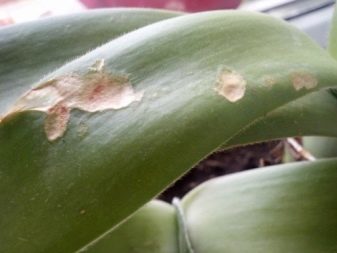
Blackening of buds occurs due to low temperature, cold water and high humidity.
The reason for the slow development is "empty", non-nutritious soil. But if at the same time spots appeared on the leaves, then perhaps the pests suck all the vitality from the plant.
A month after transplanting, the onion should start growing. If this does not happen, then it can be activated by growth stimulants. If after that, within 2-3 weeks, new leaves did not appear, it means that the conditions of the dormant period were violated, because of which the bulb became unviable.
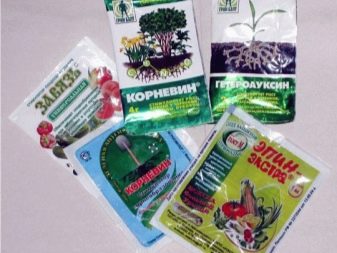
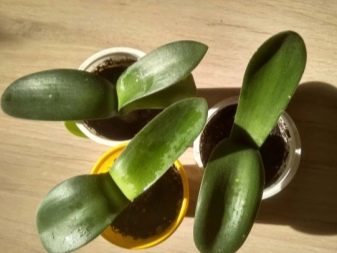
Diseases and pests
Hemantus has good immunity to diseases and pests. But, for example, overflow can lead to rotting of the root system and the bulb itself. The consequence is the development of fungal diseases, which are fought by removing the diseased part of the plant and treating it with fungicides.
But the flower can also get sick from hard water - a gray bloom appears on the leaves. In this case, it is necessary to settle the water longer or use a filter.
Fortunately, the "deer's tongue" also has few insect pests, but it is imperative to fight them. All of them easily move from plant to plant, which means that soon all flowers may suffer.
- Red spider mite braids the entire flower with cobwebs, and lays eggs in the ground. The problem is that they can be stored there for up to 5 years. The reason for the appearance is too low humidity and high temperature in the room. The way of prevention is bathing the foliage (but not the bulbs!), Preferably with soapy water. Control methods - insecticide treatment, preferably once a month for a quarter. If this method does not help, then the plant must be transplanted into a new pot with new soil.
- Shield - a pest that can harm all indoor plants. Florists are advised to first collect these oval insects from the leaves by hand or with a brush, and then treat them with insecticidal preparations.
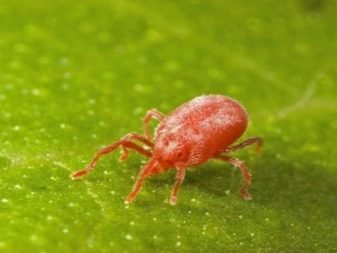

The main thing is that when the first signs of a disease appear on any plant, it is immediately transferred to the quarantine zone so as not to infect other flowers.
For more information on Hemanthus, see the video below.























The comment was sent successfully.